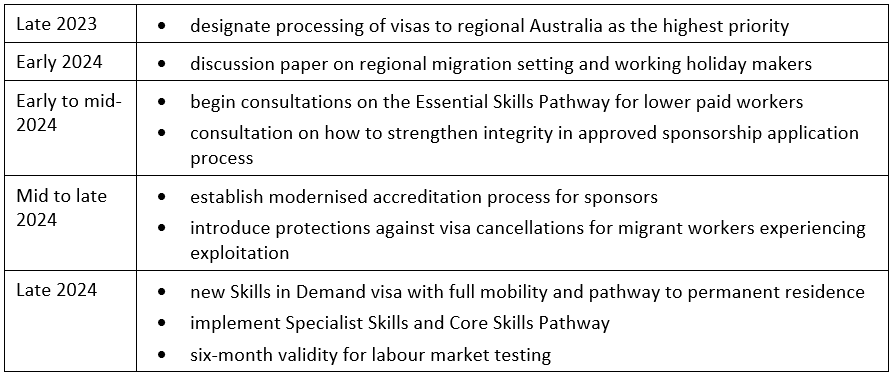
As we approach the end of this year, we round-up the latest developments in the employer sponsored space and share insights into what the government’s migration strategy has in store for you.
There has been a change to labour market testing from 11 December. The changes remove the requirement to advertise all nominated positions on the Workforce Australia platform (yay!) and clarify the requirements for overlapping advertisements.
An overlapping advertisement may be where an advert is posted on a platform for 14 days and then re-run for a further 14 days – to make up the 28 needed. For labour market testing purposes, there must be an overlap of at least one day for these advertisements to satisfy the requirements and overlapping days are only counted once.
For example, if an advert was posted on 1 December for 14 days, a second advertisement would need to be posted on 14 December for a further 14 days. There must be at least one day that overlaps and both adverts must run for a minimum of 28 days.
Where possible, we recommend all adverts be placed for the maximum timeframe of 30 days to avoid running into any difficulty.
All subclass 482 visa holders now have a pathway to permanent residence regardless of their occupation under the subclass 186 Employer Nomination Scheme Visa, Temporary Residence Transition Stream.
This is an employer sponsored visa and, like the subclass 482 visa, includes both a nomination and a visa application. To be eligible, the employee must have held a 482 visa sponsored by your business for at least two years and have worked in the position for at least two years on that visa.
They must also be earning a salary greater than the new Temporary Skilled Migration Income Threshold of $70,000 plus superannuation. The position must also be available for at least two years from visa grant.
We are still waiting for some policy on the application timeline for individuals holding 482 visas in the short-term stream, which only allows for a two-year visa. Those who were already in Australia and working in your business may be able to lodge an application a couple of days before their 482 visa expires. For those who were offshore at the time of the grant or who have taken periods of unpaid leave, they may need to apply for another 482 visa before becoming eligible to apply for permanent residence.
On 31 December 2023, any person on a Working Holiday Visa who commenced with your business before 1 July 2023 will reach the six-month work limitation.
Previously, there were some waivers to the work limitation for plant and animal cultivation, work in certain high-demand industries in Northern Australia, or work in different locations, where work in any one location does not exceed six months.
According to the latest resources from the Department of Home Affairs (Department), there are no exceptions to the six-month work limitation. However, the Department expects the Minister’s Office to release interim policy settings to address this issue within the next week. We will circulate this as soon as it is available.
In the meantime, for any working holiday maker that will reach six months by 31 December and would have fallen under one of the exemption categories, we recommend contacting the Working Holiday Maker section requesting permission in writing to work beyond the six months. To make this request, download Form 1445 here and send it to working.holiday@homeaffairs.gov.au.
Working holiday makers who has applied for another visa should send the request to the visa processing area.
The migration strategy released last week focuses on the employer and skilled migration program reforms. The strategy has five core objectives:
For the employer sponsored program we expect to see the following things happen:
Closure of 482 visa
The subclass 482 visa will close to new applications by the end of 2024 and be replaced with a new Skills in Demand visa. While this visa will be very similar to the subclass 482 and consultation on some aspects of it is still required, some key changes have been highlighted:
Within this new visa will be visa pathways, these include:
Labour market testing
We expect more changes to the labour market testing requirement which will extend the validity of job advertisements from four months to six and possibly a move away from employer conducted labour market testing to a genuine independent verification of needs approach.
Other changes
There will be changes to the student visa and working holiday visa programs which may impact employers. We will keep you informed of anything that impacts you as an employer.
Timeline
These changes won’t come in overnight and many details are still pending. Based on the information in the strategy, we expect the following implementation timeline:

2024 will certainly be an exciting year in the migration space. If you have any questions about the above changes, please get in touch with us below.
Published by: